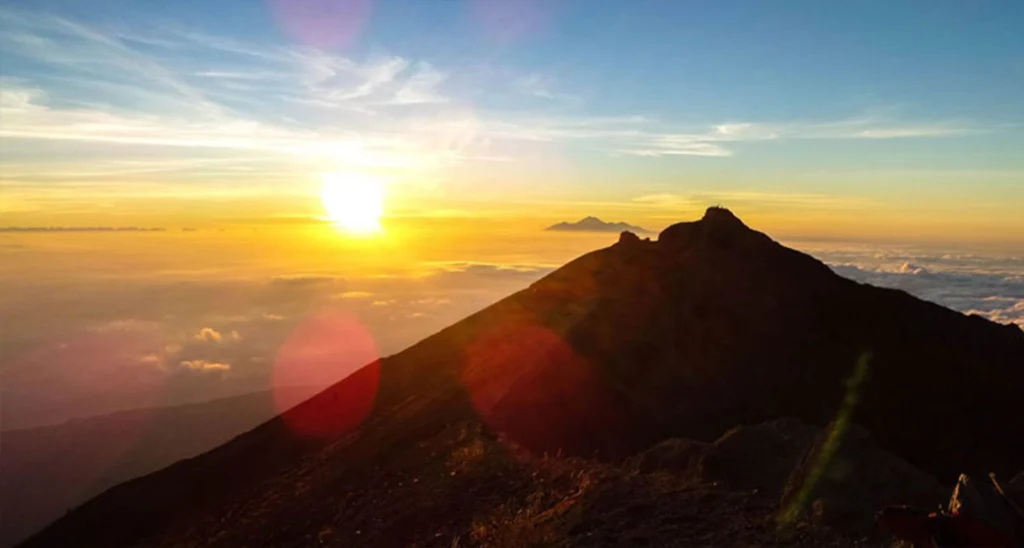Mount Agung
Witnessing sunrise from the highest point of Bali is an unforgettable adventure.
Minimum 2 persons

- Located : Bali,Indonesia
- Highest point : 3,142 MASL
- Duration : 7 – 8 hours
- Difficulty level : Challenging
- Best time to go : April – September
MOUNT AGUNG HIGHLIGHTS
The Balinese believe that Mt. Agung is the abode of the gods, and the volcano, therefore, is revered as sacred.
Standing majestically on the eastern seaboard of Bali is the island’s highest mountain: Mount Agung, located in the district of Karangasem.
With its summit reaching a height of 3,142 meters above sea level, Mt. Agung affects its surrounding climate.
Its western slopes catch the rain clouds making the west side lush and fertile, while its eastern slopes remain dry and barren.
Mount Agung Eruption History
Although Mt. Agung inspires peace and tranquility, nonetheless, after 100 years of slumber In 1963, Mt. Agung burst violently, spewing ash
and volcanic materials 8 to 10 km high into the air while pyroclastic clouds rolled down all sides of the mountain. a catastrophic eruption wiped out the nearby villages
and killed 2,000 people. The last Mt. Agung eruption was the one in 2017-2019, when it exploded with a giant 4 kilometer tall ash cloud that caused mayhem in Bali.
More than 100,000 locals in Karangasem were evacuated, and hundreds of tourist flights were canceled or diverted.
Is Mount Agung Safe?
Nowadays, any signs of impending volcanic activity at Agung are constantly monitored by the Indonesian government,
and if there are tremors sometimes the mountain is closed to hikers.
Weather / Climate at Mount Agung
Even though this is Indonesia, Mount Agung can be pretty chilly before sunrise since it’s well above sea level.
Temperatures in the early morning can drop below 7 Celsius (45 F), and it can get windy too since you’re on an exposed mountain.
However, after sunrise it warms up a bit. It’s best to dress in layers, because when you’re hiking up the mountain you’ll warm up pretty quick and may even get hot.
Best time to visit Mount Agung
Indonesia’s dry season runs from April to November, and during this time there’s less rain and the mountain visibility is best.
You can still visit Mount Agung during the rainy season (December to March), and the mornings are normally clear.
Mount Agung Sample Itinerary
- 18.00 : Pick up from hotel and heading to Mt.Agung trekking point (it takes around 2,5 hours)
- 21.00 : Arrive at Starting Point of the trek
- 22.00 : Begin the trek to reach the summit. (it takes at least 7 – 8 hours)
- 06.00 : Enjoy mesmorizing view and sunrise from the Top of Holiest Volcano in Bali
- 07:00 : Begin the descent towards the finishing point of the trek. (it takes at least 7 – 8 hours)
- 11.00 : Arrive at the finish point
- 14:00 : Estimated time of arrival in your hotel
Mount Agung
Estential things to carry
- Trekking Shoes – For Comfort And Strong Grip
- Trek Pants – For The Ultimate Comfort
- Powerbank – Keep Your Gadgets Charged
- Sunblock/lotion, hat/cap, sunglasses
- Windproof Jacket, Warmest jacket
- Personal Medical Kit
- 1 pcs. of T-Shirts
- Sandals (optional)
- Gloves
Trekking Included
- Pick up and transfers after the trek
- An experienced English speaking trekking guide
- Breakfast (Sandwich, fruit, drinking water,tea, coffee)
- Insurance provided by National Park
- National Park ticket entrance
- Headlam and Trekking poles
- Small bag/daily pack
- First aid kits
Trekking Excluded
- Travel Insurance
- Personal Expenses
- Tips for guide
